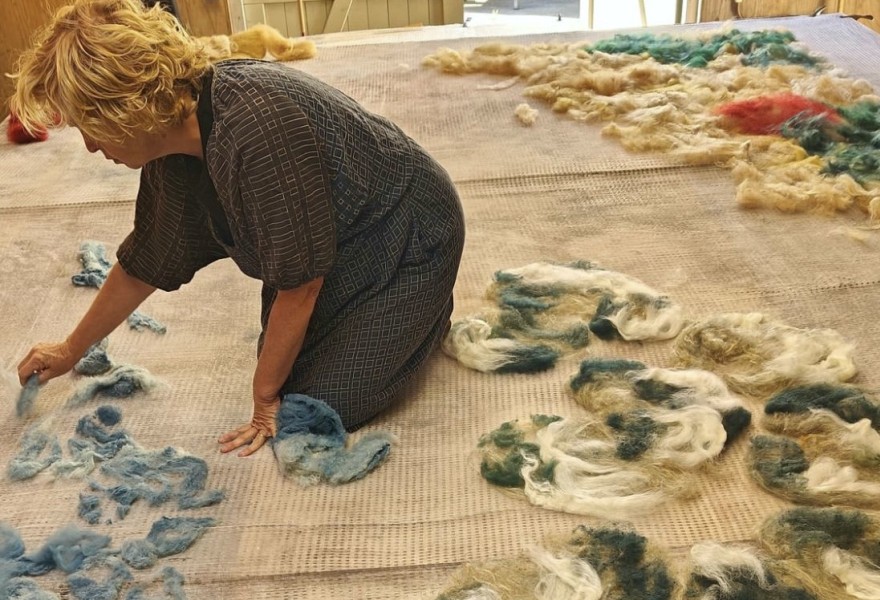17 october 2024, Flor Linckens
Claudy Jongstra: wool as a carrier of craftsmanship, history and metaphor
Until 26 October, Galerie Fontana in Amsterdam presents the exhibition 'ATMOSPHAERA' by Claudy Jongstra. In this exhibition, the artist showcases a selection of her latest works, instantly recognisable through her distinctive use of wool and natural pigments. Jongstra creates poetic, layered and sculptural wall pieces and installations that invite us to reflect on the complex interplay between humanity and nature.
With a craftsman’s approach, the artist processes wool into felt, one of the oldest forms of textile, which she then dyes using plant-based pigments. Her work embodies a fusion of ancient crafts and innovative contemporary techniques, always with deep respect for humanity, its (cultural) history and transmitted knowledge, and above all: nature. During her 2020 exhibition at De Lakenhal museum in Leiden, visitors were given a small sample of wool at the entrance to provide a tactile experience — since the works themselves could not be touched. The card attached to the sample asked: ‘Are we still capable of truly using our senses in this day and age?’. Sensory perception thus plays a central role in the artist’s practice.
Jongstra’s artistic practice is a continuous exploration of the relationship between art, ecology, sustainability and activism. Her holistic approach to materials is reflected in her largely circular production chain. In 2001, she opened her studio in Friesland, just half an hour from Leeuwarden, where she initiated an ecological experiment that has since become a model for sustainable entrepreneurship. For her work, Jongstra uses wool from her own flock of more than one hundred rare Drenthe heath sheep, the oldest breed in Northern Europe, and pigments derived from plants grown in her specialised biodynamic garden, which also helps preserve certain species. Jongstra, for instance, uses indigo, a golden-yellow pigment from onions, and red pigment from madder root. By employing ancient dyeing recipes, she transforms these pigments into paint. Through these practices, the artist actively resists the loss of biodiversity in her environment. Her studio’s self-sufficient approach extends beyond an ecological statement: it is a plea for the revaluation of craftsmanship and biodiversity, values that have come increasingly under threat in a society dominated by efficiency and (over)consumption. Her work radiates passion, resilience and a quest for harmony, standing as a powerful response to the disrupted relationship between humanity and nature and the impacts of climate change.
Despite the self-sufficient nature of her practice, collaboration is central to Jongstra's work. She frequently partners with local schools, farms and social programmes, including those focused on underprivileged youth and newcomers. This makes her practice not only regenerative but also inclusive. Her studio is a close-knit collaboration between her team and her partner, Claudia Busson. When her son also expressed interest in continuing the business in the future, the project truly became intergenerational.
Another key collaboration is with the Odin farm De Beersche Hoeve in North Brabant, where Jongstra and her team grow dye plants. For instance, the fresh harvest of yellow chamomile was used to achieve a vibrant yellow colour. In 2022, for the first time in over a century, a large-scale harvest of the woad plant, historically grown on Dutch fields, took place at this biodynamic farm. Known for the deep blue colour used by artists like Van Gogh and Vermeer, woad is processed by Jongstra in her works, which carry subtle art-historical references as a result.
In her organically shaped works, Jongstra experiments with composition, colour, texture and natural materials. Wool forms the core of her practice. This is not a random choice of material — it is known for its protective properties, rendering it a powerful metaphor. Moreover, wool possesses a unique combination of qualities that cannot be chemically or synthetically replicated. In addition, Jongstra works with materials such as merino wool, mohair, linen, silk and cotton, and she experiments with traditional techniques such as carding, spinning, weaving and guipure lace-making. Her practice is rooted in deep material and colour research, as well as historical research into dye and craft techniques from the 15th and 16th centuries, supported in part by the Niemeijer Fund.
Claudy Jongstra, born in 1963 in Roermond, studied fashion design at the Utrecht School of the Arts (HKU), after which her career moved toward being an autonomous artist. Her work has been included in the collections of institutions such as the Stedelijk Museum, the Victoria & Albert Museum in London, the Los Angeles County Museum of Art (LACMA), MoMA in New York and San Francisco, the Centraal Museum, Museum De Lakenhal and the Fries Museum, as well as in private collections of celebrities like Adele and Brad Pitt. She has also created textiles for artists and designers like Hella Jongerius, Maarten Baas, Christian Lacroix, John Galliano, and Viktor & Rolf. Moreover, she supplied fifty meters of felt for the movie The Phantom Menace – Star Wars Episode 1 (1999), used in the iconic Jedi capes. One of her large-scale works (6.80 x 3.50 m) now hangs in Brussels, in the new headquarters of the Dutch Embassy and the Permanent Representation of the Kingdom of the Netherlands to the European Union, where it engages in a meaningful visual dialogue with an 18th-century tapestry depicting a shepherdess. In 2005, she received the Amsterdam Prize for the Arts, and in 2019, she was named Artist of the Year and inducted into the Academy of Arts, a section of the Royal Netherlands Academy of Arts and Sciences.



